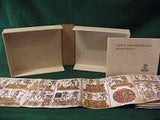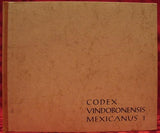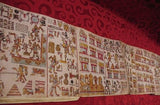Codex Vindobonensis Mexicanus I
Author: Adelhofer, Otto (editor)
Year: 1974
Publisher: Akademische Druck - u. Verlagsanstalt
Place: Graz
Description:
2 volumes. Text volume. 37 pages with facsimiles, figures, tables, four plates (2 in color and one foldout pictorial) and bibliography. Oblong quarto (10" x 12") text bound in original publisher's wrappers. Codex true-color facsimile edition of the hand painted manuscript in possession of the Austrian National Library, Vienna. 52 folded pages folded continuously in PreColumbian screen-fold format. The facsimile and commentary volumes are together presented in a boxed edition with quarter leather spine in gold lettering to spine and brown lettering to cover. Volume 5 of the series Codices Selecti. First edition in this series.
Codex Vindobonensis Mexicanus I, counted as the most beautiful and detailed of the hand painted Mixtec books this treasure of ancient Mexico has been in the Vienna National Library (previously the Imperial Library) since 1677. It is a prehispanic Mesoamerican screen-fold manuscript painted on deer-hide, is one of the few pictorial documents to have survived the pre-Conquest period. Although its exact provenience is unknown, originated in the Mixteca, an area of southern Mexico. Other screen-fold manuscripts from the Mixteca survive that are also painted in the "native style," that is, without any trace of European iconographic or stylistic influence even if they were executed soon after the conquest. Codex Vindobonensis Mexicanus I, is presently located in the Nationalbibliothek in Vienna, but its prior history is somewhat obscure. It seems to have arrived in Europe soon after the conquest of Mexico. A Latin inscription on folio 2 verso states that the codex was at one time in the possession of King Manuel I of Portugal, who died in 1521. The inscription suggests that the manuscript had reached Europe prior to the date of the King's death. Whenever it arrived in Europe, the survival of this fragile masterpiece makes it a unique document, for it is the only assuredly Mixtec "ritual-mythological" manuscript. Its importance lies in the fact that had it not survived, it would be difficult to determine the identities and roles of Mixtec deities and the form and content of some Mixtec rituals. Spread to its full length, the codex is about 1350 centimeters long. The manuscript is folded into fifty-two pages of its obverse are painted, and at some time during the its European history, the pages were erroneously numbered from left to right with Arabic numerals. The obverse is correctly read from right to left, that is, from page 52 to page 1, in an unusual vertical pattern provided by red guide lines. Only thirteen pages of the codex reverse were painted in the more common horizontal reading pattern. The obverse and reverse of the codex were painted by different artists, perhaps at different times. The beautifully drawn obverse is concerned with the deities, place signs, and rituals. In his analysis of the less skillfully rendered reverse, Alfonso Caso demonstrated that the thirteen pages provide a brief account of the lineage of Tilantongo, a prominent ruler, a male usually called 8 Deer "Tiger Claw," or more properly "Jaguar Claw."
Condition:
Texted corners bumped, edges light rubbed. Slip case stained at back hinge else a very good set.
Year: 1974
Publisher: Akademische Druck - u. Verlagsanstalt
Place: Graz
Description:
2 volumes. Text volume. 37 pages with facsimiles, figures, tables, four plates (2 in color and one foldout pictorial) and bibliography. Oblong quarto (10" x 12") text bound in original publisher's wrappers. Codex true-color facsimile edition of the hand painted manuscript in possession of the Austrian National Library, Vienna. 52 folded pages folded continuously in PreColumbian screen-fold format. The facsimile and commentary volumes are together presented in a boxed edition with quarter leather spine in gold lettering to spine and brown lettering to cover. Volume 5 of the series Codices Selecti. First edition in this series.
Codex Vindobonensis Mexicanus I, counted as the most beautiful and detailed of the hand painted Mixtec books this treasure of ancient Mexico has been in the Vienna National Library (previously the Imperial Library) since 1677. It is a prehispanic Mesoamerican screen-fold manuscript painted on deer-hide, is one of the few pictorial documents to have survived the pre-Conquest period. Although its exact provenience is unknown, originated in the Mixteca, an area of southern Mexico. Other screen-fold manuscripts from the Mixteca survive that are also painted in the "native style," that is, without any trace of European iconographic or stylistic influence even if they were executed soon after the conquest. Codex Vindobonensis Mexicanus I, is presently located in the Nationalbibliothek in Vienna, but its prior history is somewhat obscure. It seems to have arrived in Europe soon after the conquest of Mexico. A Latin inscription on folio 2 verso states that the codex was at one time in the possession of King Manuel I of Portugal, who died in 1521. The inscription suggests that the manuscript had reached Europe prior to the date of the King's death. Whenever it arrived in Europe, the survival of this fragile masterpiece makes it a unique document, for it is the only assuredly Mixtec "ritual-mythological" manuscript. Its importance lies in the fact that had it not survived, it would be difficult to determine the identities and roles of Mixtec deities and the form and content of some Mixtec rituals. Spread to its full length, the codex is about 1350 centimeters long. The manuscript is folded into fifty-two pages of its obverse are painted, and at some time during the its European history, the pages were erroneously numbered from left to right with Arabic numerals. The obverse is correctly read from right to left, that is, from page 52 to page 1, in an unusual vertical pattern provided by red guide lines. Only thirteen pages of the codex reverse were painted in the more common horizontal reading pattern. The obverse and reverse of the codex were painted by different artists, perhaps at different times. The beautifully drawn obverse is concerned with the deities, place signs, and rituals. In his analysis of the less skillfully rendered reverse, Alfonso Caso demonstrated that the thirteen pages provide a brief account of the lineage of Tilantongo, a prominent ruler, a male usually called 8 Deer "Tiger Claw," or more properly "Jaguar Claw."
Condition:
Texted corners bumped, edges light rubbed. Slip case stained at back hinge else a very good set.











